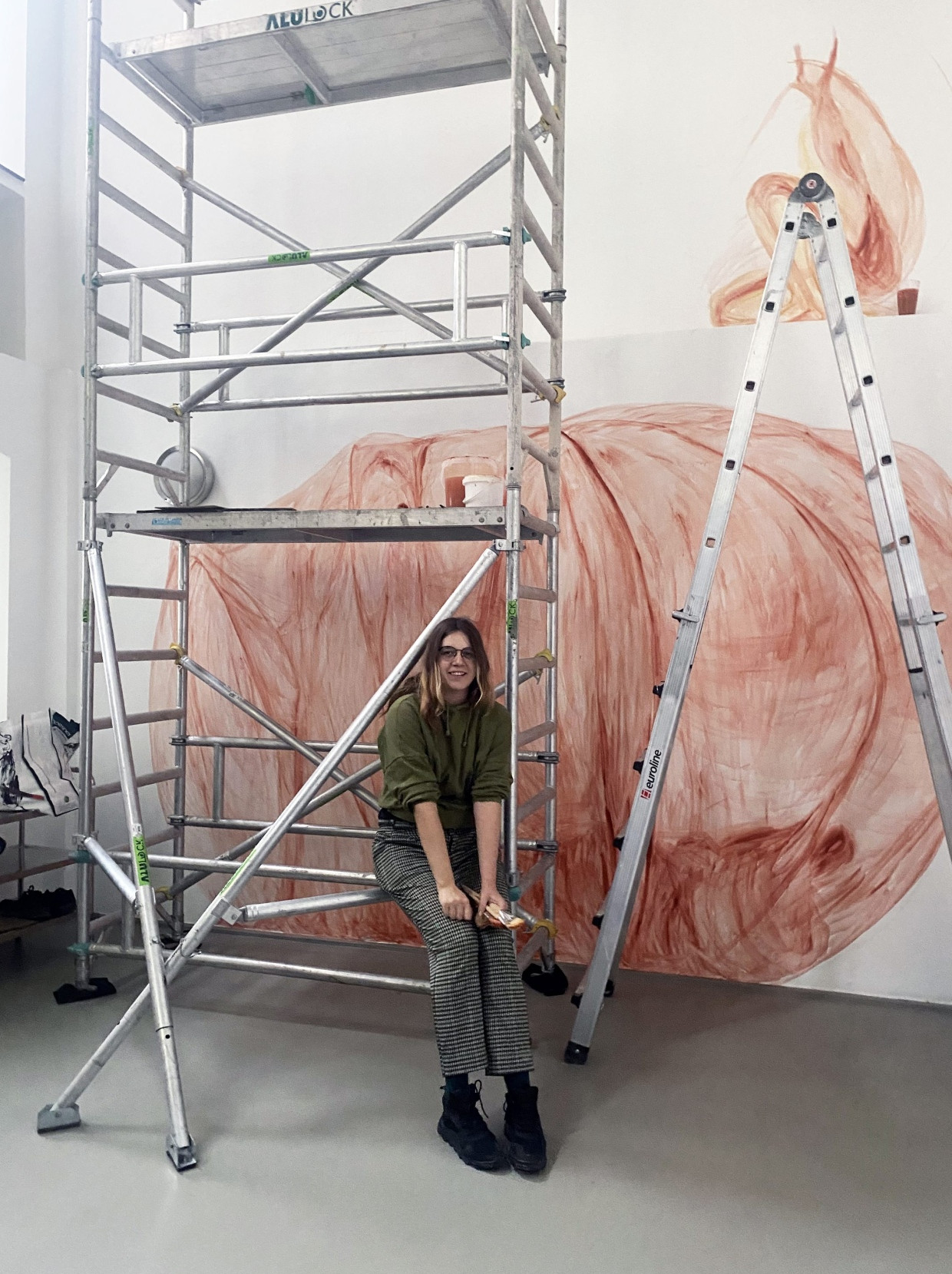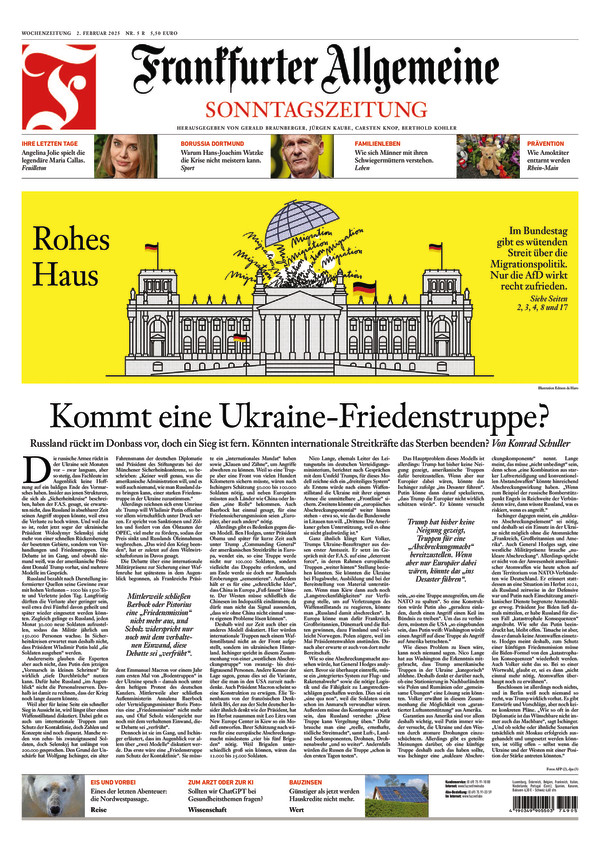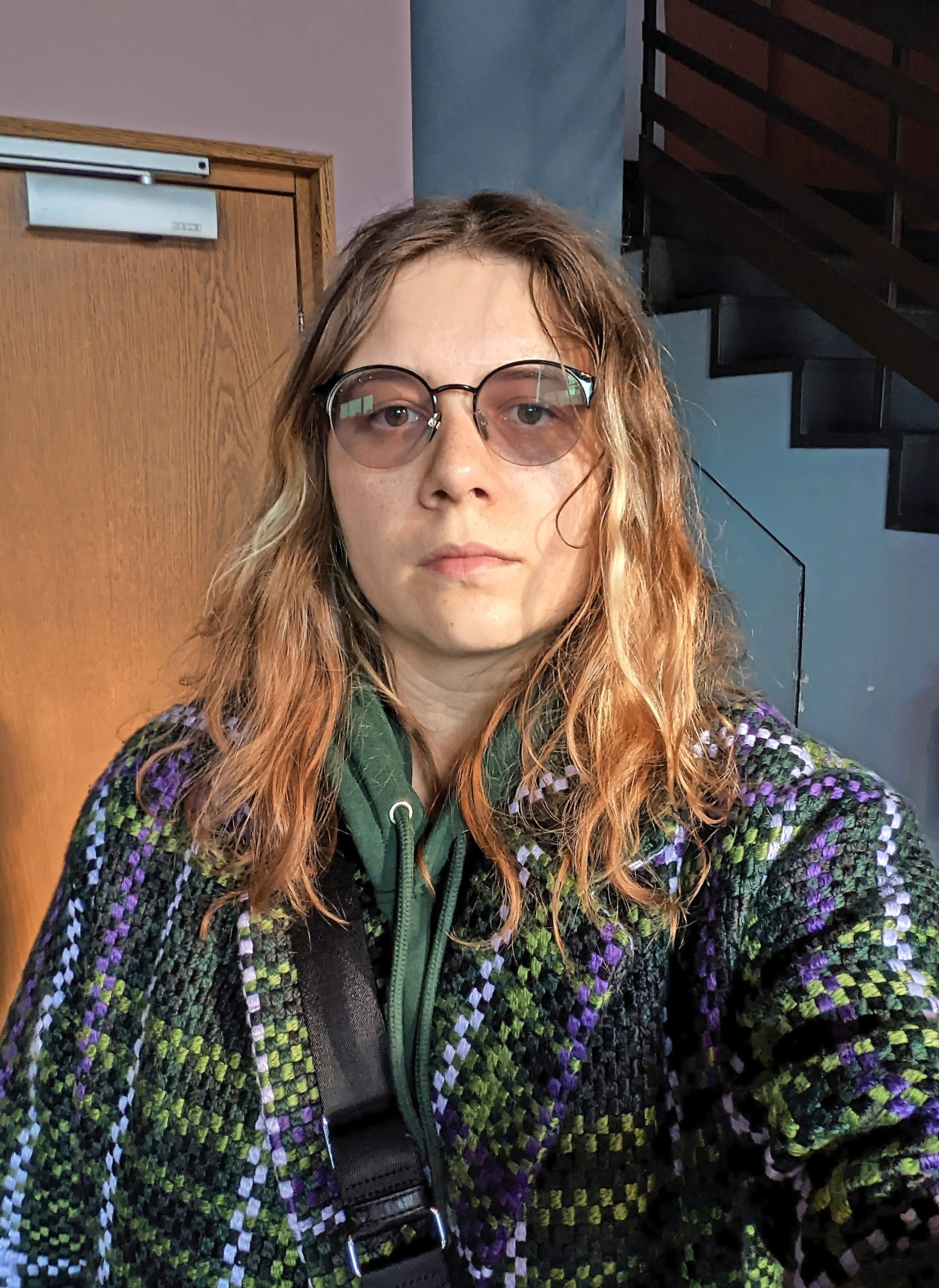Auf Kiew schießen russische Drohnen. In Wien regiert bald ein Kreml-Fan. Und in Hannover lehnen Kateryna Lysovenkos Gemälde an den Wänden des hiesigen Kunstvereins, wie Säulenheilige, die von all dem nichts wissen wollen. Zentauren, Spinnenmenschen und andere Fabelfiguren lauern stumm auf den Leinwänden. Luftpolsterfolie und Schaumstoffecken liegen am Boden verteilt, Lysovenkos erste Einzelausstellung in Deutschland, „Animals“, eröffnet an diesem Samstag.
„Ich habe Albträume“
Und trotzdem, Russlands Krieg ist zu so was wie der unsichtbaren Hand im Leben der ukrainischen Künstlerin geworden. Am 24. Februar 2022 schlagen Raketen ins Elektrizitätswerk rechts von ihrer Wohnung in Kiew ein. Am 25. in die Militärbasis links davon. Die Fensterscheiben zerbersten unter dem Druck, aus den Scherben rettet sie sich selbst, ihre beiden Kinder und ihre Gemälde. Kateryna Lysovenko flieht nach Luzk, am 1. März 2022 überquert sie die Grenze. Dann ins österreichische Graz, wo sie am Kunsthaus das Wandbild „Shameless earth does not remain dead for too long” zeigt. Sie landet in Wien, wo sie seitdem mit ihren Kindern lebt. Jetzt droht aber auch Österreich zum unsicheren Ort zu werden – ein FPÖ-Kanzler Kickl könnte kommen. „Ich habe Albträume“, sagt sie am Telefon, „dass sie mich in russische Konzentrationslager stecken oder die Nazis welche in Österreich errichten, wie sie es schon mal getan haben.“ Lysovenkos Stimme: lakonisch. Neu scheint ihr die Angst nicht zu sein, sie spricht auch über ihre jüdische Familie.
In Hannover ist das anders: Breitbeinig, mit locker sitzendem Bauchbeutel um die Hüfte, steht Kateryna vor mir. Sie reicht dezent die Hand, schaut neugierig unter ihrer Brille hervor, sagt ein paar schnelle Sätze und verabschiedet sich dann wieder ins Treppenhaus. Ich folge ihr. Auf der Treppe sitzt sie mit einer großen Palette in der Hand, neben ihr eine Bühne aus Aluminium, dank der sie auch in fünf Meter Höhe noch malen kann. Kateryna schmeißt in schnellen Strichen das stark verwässerte Ockergelb auf die weiße Wand des Treppenhauses, langsam bildet sich ein aufgeblähter Kokon darauf ab.
„Ich mal die neun Höllenkreise“
„Ich male die neun Höllenkreise, wie bei Dante“, sagt sie und deutet auf die schwindelerregend hohen Stockwerke über und unter uns. Dünnhäutige Wesen ziehen auf den Wänden vorbei, beten hervorstehende LED-Lampen an, kriechen entlang der Fußleisten und lösen sich Stockwerk für Stockwerk in organischen Formen, in Abstraktion auf. „Angel folding the sky“ heißt die Wandarbeit. Unter der Treppe bäumt sich der namensgebende Engel auf, ochsenblutrot, und faltet mit beiden Händen einen der riesigen gemalten Kokons zusammen.
Bilder einer vergessenen Zeit
Auf dem Handy zeigt mir Kateryna die Fotografie eines byzantinischen Freskos aus der Kirche des heiligen Kyrill in Kiew. Darauf die verblassten Überreste eines Engels, der den Himmel wie Pergament zu einer Schriftrolle aufrollt. „Eine Revolution“, sagt Kateryna, „ein neues Kapitel beginnt.“ Der Engel, den sie mir zeigt, ist Teil des Ensembles „Jüngstes Gericht“ aus der Zeit der Kiewer Rus, auf deren historischem Erbe die ukrainische Nation fußt. Im 19. Jahrhundert wurden die Fresken teilweise wieder freigelegt, die Kirchenwände gleichen heute einem Flickenteppich, genauso Katerynas Treppenhaus. Mit den spärlich verteilten Malereien an der Wand, den herumliegenden Pinseln, den Bodenplanen und der Alu-Bühne wirkt es wie im Zustand einer Restauration. Hinter der weißen Fassade verbergen sich Bilder einer vergessenen Zeit, Kateryna legt sie frei, arrangiert sie neu. Ist das ihre Revolution?

I stand one half floor below, watch her at work. For a moment Kateryna kneels on the steps, like the painted angel under her. This is not staged, even if she looks at Fresko painting, as if she held all the rope in her hand as if she had an old master Michelangelo, who overlooks his Sistine chapel. Monumental composition, stage design and Fresco learned Kateryna early after she was born in the Kiev of the decaying Soviet Union in 1989 and studied in Odessa at a classic art school – still “in the Soviet system”, as she emphasized.

Dieser Text stammt aus der Frankfurter Allgemeinen Sonntagszeitung.
She continued her studies at the Academy of Fine Arts and Architecture in Kiev, dealt with contemporary concept art and suddenly felt like a “stupid painter” and not like a “smart artist”. She didn't want to paint as she had learned. Kateryna speaks of “disappointment” and “alienation”, but also of “liberation”.
A crunching process
In general, when she tells of the development of her medium, it sounds after a great outbreak, after RoadTrip, after the first night in the club, without parents, without plan and without security. Her way back to painting, a crunching process of emancipation: “In Ukraine, it was often said that as a woman I could not be an artist. But the more my working practice developed, the more I found my feeling as a painter. ”Names of artists like Mychajlo Bojtschuk or Sofia Nalepinska are therefore heard more often. Both were representatives of Ukrainian monumentalism, both fell victim to Stalinist cleansing in 1937, such as the entire movement. Her style, which represented everyday Ukrainian life in a reduced, Byzantine tradition, was pursued as an anti -sowing fault factor.
The spirits of the monumentalists also want to free Kateryna, but without monuments. The traditional painting technique is still in her hand, only their characters are fragile, the scenes in which they paint them are rushed from everyday life into the mystical past of mythical creatures. A few years ago, Kateryna discovered written records about antique wall paintings, which – unlike the sculptures that everyone knows – have been destroyed over time. Like Ki-Prompts, Kateryna paints what she reads: sketches babies with heads of calves, and androgyne throws on the canvas, the milk sprayed out of their nipples, centaur children, who are apathetically hand in kindergarten, and lets her characters in desert landscapes and dirty earth tones. Only a thin silhouetting line gives them contour.

Including perspectives and the cut -out format of the pictures make you everyday surreal scenes. Something like the Behind-the-Scenes ancient myths-or just what happens in the shadow of monuments, dictatorships and ideologies.
In Hanover, the space in which this series of work from 2019 to 2021 can be seen is overwritten with the word “paradise”. “I wanted a paradise for the victims of the story, where the absentees are present,” says Kateryna. She made this idea the clearest in Venice. In the Palazzo Contarini Polignac, she painted the walls of a court passage with Bible figures for the accompanying exhibition of last year's Biennale – “Rewriting the Bible”. At the end of the passage, a wooden door opened. Lagoon air pulled through, and the view was clear to the Venice underneath in the sea. Leaves of desert roses, which the artist couple Allora & Calzadilla had interpreted there, laid over the ground. And Kateryna's wafer -thin paintings suddenly looked like frozen shadows, like preserved time, like an oasis of the undead.
Iconic poses
Already in Venice I wondered: Isn't that terribly kitschy? Esoteric? Symbolistic? Folklore? The iconic poses, the blood -red bodies of the mother figures, the mythical creatures? Now I am in Hanover and ask myself again. But then grab something. This trace of violence in the pictures, the exuberant fresco blue, which flushes the symbolist forms threatening. The negative space between the figures. The accurately shining color fields, which suddenly begin to live, break out of the background and tear the contours in Kateryna's painting as if they brushed off a dead shell.
This color brew has been raging on Kateryna's pictures since 2022. Now there is a dark-explosive conglomerate made of bodies. Human, animal, indefinite. It's like the painter Miriam Cahn and her portraits. They become scary because behind the faces the life of the colors pushes outwards, recognizable shapes pulled into limitless depths. In Kateryna's pictures you encounter this deep ghost. Ghosts of what remains in history and: in Putin's war. Kateryna says: “After the war started, I could no longer paint within clear limits. Life didn't feel like this anymore. ”Kateryna's life is the colors. And there is the war there.








